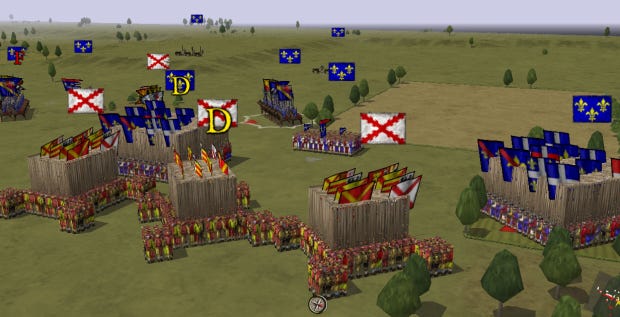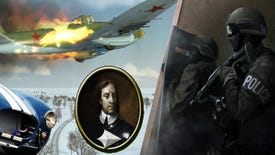Wot I Think: Pike And Shot
Looks like a roundhead, plays like a cavalier
The Sixteenth Century equivalent of a Tiger tank was called a tercio. With a crew of between 1000 and 2000 souls, it moved extremely slowly, relying on its porcupine bristle of polearms for defence and its buttresses of constantly circulating arquebusiers and musketeers for attack. To have faced one of these ball-spewing, smoke-wreathed behemoths in battle would have been truly terrifying. To have had one (or three - they usually operated in trios) at your disposal as a general, would have been incredibly empowering. Why aren't tercios as famous and fondly regarded in PC wargaming circles as the iconic Panzerkampfwagen VI? Search me. Pike and Shot proves that they can be every bit as satisfying to steward as their Sherman-savaging descendants.
Pike and Shot really shouldn't work half as well as it does. Built using an engine designed for WW2 warfare, and lacking a campaign layer, it looks from a distance like an opportunistic lash-up. It's only when you draw close - sample a few of the 30 bundled battles - that you realise that this hex-spurning 16th/17th Century tactical TBS is far more than just Battle Academy 2 in a breastplate and morion.
The pace and approachability of Slitherine's WW2 charmer is there, but there's an energy and unpredictability to P&S scraps that is entirely new. Engagements that start out lumpen or linear - unpromising army collisions on flatish plains - frequently fragment into scattered skirmishes that swirl, surge and merge in a wonderfully unscripted fashion.
The generous pinch of black powder in the game's flash pan is an automatic pursuit/evasion behaviour that regularly wrests unit control away from the player. Mid-way through a scenario it's not uncommon to find that half of your units are deaf to orders. Some will be unbiddable because they are locked in close combat (once triggered, melee can't be manually escaped), some because they're panic-stricken and fleeing. Enthused by local victories, a few will be far too busy chasing routing foes to heed instructions.
The latter mechanism provides many of P&S's most memorable moments. When a formation breaks, the unit that dealt the shattering blow often sets off in pursuit. If during the chase (which can last several turns) the pursuers spot a tempting foe in their path, they may switch their attention to this target of opportunity. What starts as a nick in a frontline can, thanks to an auto-pursuit cascade, quickly develop into a gaping rift.
Counterweighted by lots of player-marshalled pike jostling and musket ball exchanging (all regulated by authoritative combat maths reflecting everything from troop quality and morale, to weapon mixes, terrain, and unit facing) the freelancing rarely frustrates or dominates. What it does do is remind you that generals of the period, of any period, were cat herders not chess players.
If Byzantine Games had endowed their cats with different personalities, Pike & Shot's tidal slaughters may have been even more engaging. Currently, commanders are not represented in any way. One unit is as likely to go glory hunting as another. There's no possibility of settling nerves by rushing a Cromwell or a Rupert to a faltering portion of the front.
A compendious selection of period units partially compensates for the lack of battlefield bigwigs. Designer Richard Bodley Scott has ruthlessly plundered his Field of Glory: Renaissance army lists for unit types and force mixes. As a result you get to see the composition of European armies slowly changing over two centuries, and often find yourself facing forces that employ weapons and organise warriors in a very different manner to your own nation. An early-era French army of lancers, mercenary pikemen, and arquebus skirmishers, plays quite differently from a late-era English force of composite pike-and-shot units and dragoons.
Put together with the same scholarly eye as the army lists, the 30 historical battles are plucked from the Thirty Years War, English Civil War, and Italian Wars. In addition to fighting straightforward pitched battles, you'll end up defending cities, skirmishing at river crossings, covering retreats, tangling with relief forces, pouncing on unsuspecting columns, and operating while under naval bombardment. Scenarios can only be played from one side which is a tad disappointing, but a light pre-battle unit purchasing phase and a strong, reactive enemy AI means there's reasons to return.
Ready for the moment when you do eventually weary of the handmade scenarios is PBEM multiplayer (with file exchanges and matchmaking handled by Slitherine's labour-saving PBEM server), a battle editor, and a skirmish generator. The latter produces some very pleasing battlefields and nail-nibblingly close-run engagements, and, thanks to those army lists, can be used to evoke remarkably specific eras.
Less positively, in Pike & Shot puritanism can be found in places other than the English Civil War Parliamentarian OOB. Sound effects are sparse and repetitive. Units icons are in short supply. There's no replay facility. Battle visuals don't include corpses or lowered pikes.
Oh, and the camera is annoyingly inflexible. A simple config file edit extends the default zoom range, but there seems to be no way to vary pitch in-game at the moment (If you want the low-angle vistas visible in some of the shots in this WIT you'll have to play battles entirely from the new perspective).
Bodley Scott's rules system can feel a little priggish at times too. I'm thinking mainly of the (not uncommon) situation captured in the above image. The highlighted Roundhead pike-and-shot unit in the centre is unable to intervene in the ongoing melee between the units to its front and right, because A) Muskets can't be fired at units involved in close combat, and B) The Royalist unit involved in the close combat is mounted and can't be charged by most foot units. Apparently there are few if any accounts of foot soldiers attacking horsemen during the period but common sense suggests that the idle pike-and-shot unit would have found some way of assisting their 'disrupted' comrades.
Overlook the strict melee rules and the odd occasions when cannons pull off remarkable line-of-fire feats, and Pike & Shot battles are convincing affairs. More importantly perhaps, they never feel like foregone conclusions. However large and numerous the pike-quill porcupines advancing towards you, there's always a glimmer of hope, a faint memory of that time when you dismantled a similar force with a combination of pluck, luck, and inspired manoeuvres.
Pike and Shot is available now.























